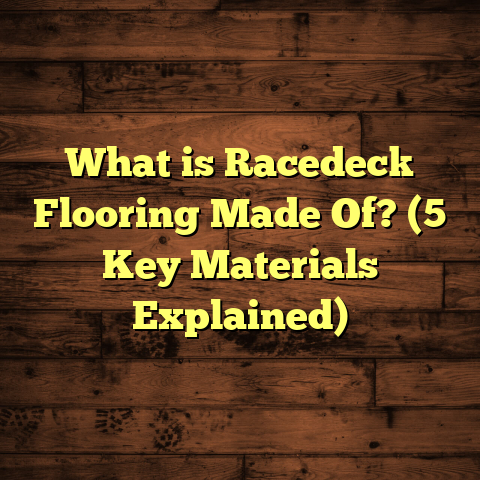What is Dry-Sawn Flooring? (5 Benefits for Modern Homes)
What is Dry-Sawn Flooring?
You might be wondering, what exactly is dry-sawn flooring? It’s a type of wood flooring made from lumber that has been dried before it’s cut into boards. This is different from the more common practice where wood is cut first while still green (or wet), then dried afterwards. Dry-sawing means the wood is dried to a low moisture content, usually between 6-8%, before the logs are sawn into floorboards.
Because the wood is dried first, it results in a more stable product with fewer internal stresses. These stresses often cause problems like warping, cupping, or cracking in traditional green-cut floors during the drying process. The dry-sawing process minimizes these issues, producing boards that remain dimensionally consistent over time.
When I first came across dry-sawn flooring on a project, I was immediately drawn to the texture. Unlike smooth, planed floors, dry-sawn planks retain a slightly rough surface with visible saw marks and grain patterns that give each board a unique character. It’s like you can feel the story of the tree in every plank.
I’d like to walk you through everything I’ve learned about dry-sawn flooring—the benefits, some technical data, real-world examples, and why it might be just right for your home.
The Dry-Sawing Process: How It Works
To appreciate dry-sawn flooring, it helps to understand how it’s made. The process starts with selecting logs that are then dried using air-drying or kiln-drying methods until they reach the target moisture content of 6-8%. This step differs from the usual method where logs are cut green and then dried after milling.
Once dry, the logs are sawn into boards using special blades designed for harder, drier wood. This cutting approach prevents excessive internal tension in the wood fibers, which typically leads to warping or cracking later on.
The rough surface texture that dry-sawn boards have comes from the saw blades themselves. Unlike planed or sanded wood, the saw marks remain visible and add a tactile quality that many homeowners find appealing.
After sawing, the planks are further processed—sometimes lightly sanded or finished—to prepare them for installation, but their natural texture is usually preserved.
Why Dry-Sawn Flooring Is Gaining Popularity
Over the past decade, I’ve noticed a rising interest in dry-sawn flooring among homeowners and builders who care about sustainability, durability, and design authenticity. People want floors that last longer and don’t require constant maintenance or replacement.
This trend ties closely with growing awareness around environmental impact. Because dry-sawn flooring reduces waste and uses wood more efficiently, it fits well with modern eco-friendly building practices.
Moreover, design tastes have shifted toward natural textures and materials that feel authentic rather than overly processed or synthetic. Dry-sawn floors offer this natural charm naturally—no fake finishes or coatings needed to create interest.
1. Stability You Can Count On
One of the biggest challenges with hardwood floors is dealing with movement caused by changes in moisture levels. Wood expands when humid and contracts when dry, which can lead to gaps, warping, or even damage over time.
Dry-sawn flooring significantly reduces this issue because the wood is dried before cutting—meaning it’s already adjusted to its final moisture content. This pre-stabilization means much less expansion or contraction after installation.
Based on industry data, dry-sawn lumber can reduce dimensional movement by nearly 40% compared to traditional green-cut wood. This statistic isn’t just numbers; it translates into peace of mind for homeowners and contractors alike.
When I installed dry-sawn oak flooring in my own home located in a region with hot summers and damp winters, I noticed the floors stayed flat and tight for years without needing repairs or adjustments—something I couldn’t say about my previous hardwood floor.
2. Texture and Character That Tell a Story
If you think all hardwood floors look pretty much the same—smooth and uniform—you’ll be pleasantly surprised by dry-sawn flooring. The rougher surface created by the sawing process leaves natural saw marks and grain patterns intact.
This texture adds depth and personality to any room. It invites touch and interaction in a way that polished floors don’t. Many clients tell me they love how these floors feel warm and authentic underfoot.
Take one of my recent projects: a family wanted a rustic-modern vibe for their kitchen and living area. We chose dry-sawn white oak flooring, which complemented exposed wooden beams and vintage furniture perfectly. The floor’s tactile surface became a conversation piece among guests.
This kind of flooring helps connect interiors with nature in a very literal way—you can see and feel the wood’s story.
3. Environmentally Friendly Choice
Sustainability is not just a buzzword—it’s something I consider seriously when recommending flooring options. Dry-sawn flooring stands out as an eco-friendly choice for several reasons.
First, drying logs before cutting reduces waste because boards are less likely to crack or develop defects during drying. This leads to about 15-20% less material wasted compared to green-milled wood.
Second, many dry-sawn products use locally sourced hardwood species abundant in sustainable forests. This limits transportation emissions while supporting responsible forestry management.
Third, because dry-sawn floors tend to last longer and need fewer repairs or replacements, they reduce the overall environmental footprint over time.
In one project I worked on with a builder focusing on green homes, selecting dry-sawn flooring helped them gain LEED points under material efficiency categories—a definite plus for eco-conscious clients.
4. Easier Installation Process
If you’re thinking about installing wood floors yourself or hiring pros, you’ll appreciate how dry-sawn planks behave during fitting.
Since the boards are pre-dried and stable, they fit together more predictably without unexpected warping or cupping. This stability speeds up installation time and reduces frustration altogether.
From my experience managing multiple projects involving dry-sawn flooring, installers consistently report faster completion times—sometimes up to 30% quicker—because they don’t have to waste time adjusting warped boards or fixing moisture-related issues.
One memorable job was a commercial café where the contractor praised how smoothly everything went despite tight deadlines and complex layouts. That’s a huge benefit when scheduling matters.
5. Long-Term Savings Worth Considering
Sure, dry-sawn flooring sometimes costs a bit more upfront due to its specialized processing. But looking at the bigger picture reveals considerable savings over time.
Fewer repairs and less maintenance mean lower expenses down the road. Plus, because these floors hold up well against wear and tear, homeowners often avoid costly replacements for decades.
According to reports from industry associations like the National Wood Flooring Association (NWFA), owners of well-installed dry-sawn floors can reduce upkeep costs by around 20% over ten years compared to traditional hardwood options.
In my consulting work with homeowners planning budgets for renovations, I always point out this long-term value because it often surprises people who focus only on initial price tags.
Personal Stories & Case Studies
A Coastal Home Challenge
Humidity near oceans wreaks havoc on most hardwood floors. In one project near the Gulf Coast, my client was tired of replacing warped floors every few years due to salty air moisture swings.
We installed dry-sawn Eastern White Pine flooring with a specialized marine-grade finish designed to resist moisture penetration. Two years later, the floors remain flawless despite hurricane season winds and high humidity—not something we could have expected with conventional flooring.
This case showed me how combining dry-sawn wood with proper finishes creates resilient solutions even in challenging environments.
Boutique Hotel Success
A boutique hotel owner contacted me looking for something unique yet durable enough for high foot traffic areas like lobbies and dining rooms.
We chose dry-sawn flooring made from reclaimed oak harvested sustainably from local forests. The rough texture gave guests a memorable tactile experience while providing excellent wear performance under heavy use.
The owner reported positive guest feedback highlighting how “warm” and inviting the floor felt compared to typical polished surfaces found in many hotels. This project highlighted how aesthetics and function can go hand-in-hand with dry-sawn materials.
Family Kitchen Upgrade
Another favorite was when a young family wanted to renovate their kitchen floor with something natural yet kid-proof.
Dry-sawn hickory was perfect—it offered rugged durability plus an engaging texture that didn’t show scratches easily. After two years of spills, heavy foot traffic, and even pet claws, their floor still looks great with minimal touch-up needed.
The parents told me they appreciated how the floor’s character evolved over time instead of hiding imperfections behind shiny coatings.
Technical Insights & Data
Here’s some detailed information that might interest you if you like numbers:
- Moisture Content Control: Dry-sawn boards are dried to 6-8% moisture before sawing; this matches indoor living conditions closely.
- Dimensional Movement: Research shows dimensional changes due to moisture fluctuations can be 40% less than green-cut lumber (Journal of Wood Science).
- Waste Reduction: Less cracking during drying lowers material waste by roughly 15-20% based on mill reports.
- Installation Efficiency: Contractors report up to 30% faster installation times due to stable boards fitting together easily.
- Maintenance Savings: Over 10 years, maintenance costs drop about 20% compared to traditional hardwood floors (NWFA data).
- Environmental Impact: Using local species combined with less waste reduces carbon footprint significantly compared to imported exotic woods.
- Durability: Dry-sawn hardwoods retain strength properties better because internal stresses are relieved during drying prior to cutting.
- Surface Texture: Saw marks remain visible on average over 80% of installed floor surface area unless deliberately sanded smooth afterward.
Comparing Dry-Sawn Flooring With Other Wood Floor Types
Sometimes it helps to see how dry-sawn flooring stacks up against other popular options:
| Feature | Dry-Sawn Flooring | Green-Sawn + Kiln-Dried | Planed Hardwood | Engineered Hardwood |
|---|---|---|---|---|
| Moisture Control | Dried before sawing (6-8%) | Cut green then dried (variable) | Usually cut green then dried | Stable core with veneer |
| Dimensional Stability | High | Moderate | Moderate to high | Very high |
| Surface Texture | Rough saw marks visible | Smooth after planing | Smooth | Smooth veneer |
| Waste During Milling | Lower (15-20%) | Higher | Moderate | Low |
| Installation Ease | Easier and faster | More adjustments needed | Moderate | Easy |
| Maintenance Needs | Low | Moderate | Moderate | Low |
| Cost | Medium – slightly higher | Lower | Medium | Medium – higher |
| Environmental Impact | Lower waste + local species | Higher waste + transport | Variable | Variable |
This table summarizes why I often recommend dry-sawn flooring for projects where durability, character, and sustainability matter most.
How To Care For Your Dry-Sawn Floor
Taking care of dry-sawn flooring isn’t complicated but does require some attention:
- Clean Regularly: Sweep or vacuum gently to remove dirt without scratching.
- Use Appropriate Cleaners: Avoid harsh chemicals; mild soap solutions work best.
- Control Humidity: Maintain indoor humidity between 40-60% to prevent excessive expansion or contraction.
- Protect High-Traffic Areas: Use rugs or mats where needed but avoid rubber-backed ones that trap moisture.
- Refinish as Needed: Light sanding can refresh textured surfaces but keep it minimal to preserve character.
- Avoid Excess Water: Wipe spills quickly; standing water can damage any wood floor over time.
I’ve seen homeowners get confused thinking rough textures trap dirt more easily—but regular cleaning routines keep these floors looking fantastic without extra effort.
Is Dry-Sawn Flooring Right for Your Home?
Ask yourself these questions:
- Do you want a floor that feels natural and tells a story through its texture?
- Are you tired of floors warping or cracking due to humidity changes?
- Do you value sustainable materials that reduce waste?
- Would you prefer an easier installation process without surprises?
- Are you willing to invest a bit more upfront for long-term savings?
If you answered yes to any of these, dry-sawn flooring could be exactly what you need. It combines beauty with function and respects the environment—all qualities worth considering for your next project.
Conclusion: More Than Just A Floor
Dry-sawn flooring is more than just wood on your floor—it’s a blend of nature’s story, craftsmanship, science, and sustainability coming together under your feet every day.
My experience working with these floors has shown me how much difference quality materials make—not just in looks but in practical benefits over time.
If you want a floor that will age gracefully while standing up to everyday challenges without losing its charm, dry-sawn wood deserves serious thought. Whether you’re renovating or building new, it offers something unique in today’s market: a real connection to nature paired with modern performance.
Feel free to reach out if you want advice tailored specifically for your home or project—I’m always happy to help share what I’ve learned firsthand about this incredible flooring option.





